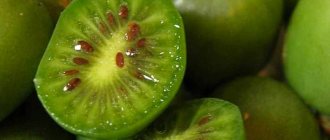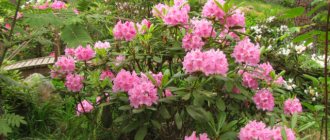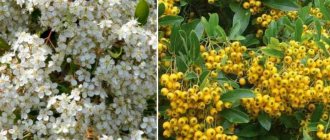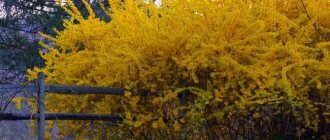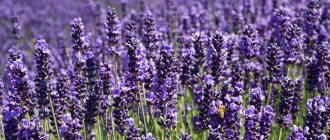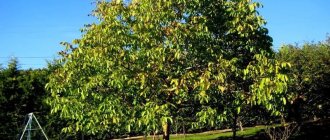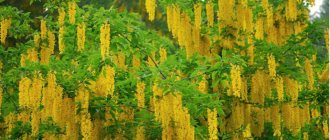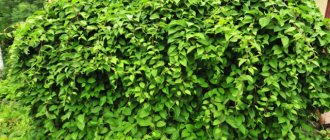What do rhododendrons look like?
With the right choice and compliance with certain agrotechnical practices, rhododendrons grow well in central Russia, including in the Moscow region.
Rhododendron is a shrub belonging to the heather family. There are up to three thousand species in total, but not all of them are suitable for the cold temperatures of the Moscow region. Among these plants there are both miniature “shooting” shrubs and fairly tall trees up to 30 centimeters in height. But the most beautiful are the so-called deciduous rhododendrons. They spread out their branches and are therefore excellent for landscape design.
Rhododendron flowers are arranged in lush clusters. They vary in size and shape - it all depends on the variety. So, they can barely reach 2-3 centimeters in diameter, while others grow up to 20 centimeters.
The advantage of rhododendron is that its flowers can have different colors. Summer residents love to create color compositions by planting rhododendrons of different colors nearby. So, there are options:
- Violet;
- Red;
- Yellow;
- Orange;
- Pink;
- Crimson;
- Raspberry;
- White.
The shape of the flowers also varies. The most popular are wheel-shaped, funnel-shaped, bell-shaped and tubular options. Inside each flower is a fruit. It is an ordinary five-leaf capsule containing small seeds.
The leaves of rhododendrons are egg-shaped. They successfully frame the plant, forming an elegant crown. There are also options when the leaves are already located on the petioles, they are deeply planted. Rhododendron roots are thin, but they are connected into a large knot. This property greatly facilitates the transplantation of an adult plant.
Rhododendrons are found in the wild in the countries of Southeast Asia. But thanks to selective methods, they are also grown in Russia. But so that the purchase of a plant does not disappoint, you must definitely know which varieties of rhododendrons will be most appropriate for the Moscow region.
Article sponsored by: Unofficial information guide to the Magnit loyalty program.
Planting dates depending on the time of year
In temperate latitudes, rhododendrons in the garden are grown exclusively of winter-hardy varieties. Planting takes place from early April to mid-May, as well as throughout the fall. It can be produced during any period of the growing season, except for the beginning of flowering and 10 days after it. However, experienced gardeners still recommend a specific planting period: from April to May 15. But the varieties planted earlier still have their advantage: by the May holidays they are already blooming wildly, which looks very impressive.
When to plant rhododendron in spring, in what month
This crop can be planted in both autumn and spring, but in this case we’ll talk specifically about the latter period. When is it better to plant rhododendron in open ground in spring? The optimal timing occurs after the end of spring frosts and before the start of flowering, that is, around May and April . In different regions of our country, due to different weather conditions, the time for planting garden rhododendron in open ground in spring differs:
- In the middle zone (including the Moscow region) - you can plant in early May.
- In Siberia, the Urals, Leningrad region - it is better to plant in mid-May.
- In the Southern regions (Krasnodar Territory (Kuban), North Caucasus) - in mid-April.
Dates for planting rhododendron in the spring according to the Lunar calendar 2020:
- Favorable dates: in April - 1, 2, 5, 6, 7, 9, 13, 14, 24, 25;
- in May - 2, 3, 4, 5, 6, 15, 16, 17, 20, 21, 25, 26, 27, 28, 29, 30, 31;
- in June - 2, 3, 4, 6, 7, 8, 12, 13, 14, 23, 24, 25.
- in April - 8, 15, 16, 17, 23;
Planting in open ground
Since rhododendron needs painstaking care, it is necessary to strictly adhere to a number of conditions:
- Choosing the right variety . Only frost-resistant varieties are taken.
- Choice of location and soil. Preferably in partial shade, without drafts and with good soil looseness. However, some varieties also grow in direct sunlight. As for the soil, it’s clear that it must be acidic, peat-based. Advice for those who have sandy soil in their garden: dig a deep hole under the plant and fill it with a mixture of peat, sand and sawdust in a ratio of 2:1:1, adding fertilizer and acidifying sulfur. It is worth digging a hole for clay soil that is not deep, but wide, filling it with the following mixture: peat as a base - 3 parts, sand - 1 part, rotted pine needles - 1 part, and leaf soil - 2 parts.
- The container with the seedling must be saturated with water. To do this, it is immersed in water before landing. The neck does not need to be deepened or raised above ground level. You should water it, making sure that the water does not drain quickly.
- Since the plant is moisture-loving, attention should be paid to the watering regime. If this is not possible, then it is better not to start growing rhododendrons at all. You need to water with acidified water. Adult bushes are watered 2-3 times a week, young bushes even more often. During the flowering period, watering is increased, supplementing the process with spraying.
- The soil must be loosened extremely carefully, since there is a possibility of damaging the root system, which is superficial for the plant. It's a good idea to think about your neighborhood by choosing trees that won't compete for food and have the ability to acidify the soil.
Site selection and soil preparation
When growing rhododendrons, the correct choice of planting location is especially important.
Did you know? Canada has one of the oldest rhododendrons. This pink tree, which is about 125 years old, can often be seen in pictures on the Internet due to its huge crown.
The criteria are as follows:
- Illumination. The plant is a sun-loving plant, but during the midday hours it is necessary to provide protection from direct sunlight. It is also worth taking care to protect the bushes from strong gusts of wind.
- The northern and northwestern sides of the garden plot are preferred.
- There must be a complete absence of neighbors such as linden, maple, spruce, birch, that is, trees with a superficial rhizome system.
- On the contrary, the proximity of trees with a deep root system is only welcome, since they protect rhododendrons well from gusts of wind and direct sunlight. These are trees such as: pine, oak, cherry, apple, pear.
- The soil should be sufficiently drained, since rhododendrons do not like excess moisture.
- Fertilize the soil with humus. It is recommended to check the pH level in this way: pour boiling water over currant leaves, cool and add a little soil. The bluish color of the water means that the soil will need to be acidified by adding rotted needles of coniferous trees. The water may change color to green, which means the soil has a neutral acidity level. If the water turns red, the soil is completely suitable for planting rhododendron, that is, it has an acidic composition.
- Care should also be taken to protect the bushes from excessive solar activity in early spring. To do this, in February or March they need to be shaded with shields on the western and southern sides.
Landing rules
The algorithm for planting rhododendrons in open ground is as follows:
- Prepare a planting hole measuring 80x50 cm, a soil mixture to fill the hole from chernozem, humus and peat, with the addition of sawdust or rotted pine needles. Ready-made mixtures for rhododendrons are available in garden centers. Before planting, place the pot with the seedling in water for half an hour to fill with moisture.
- It is necessary to fill the hole halfway with soil.
- The seedling should be carefully pulled out along with the earthen lump, and then placed in a hole.
- The root collar should be at the same level as in the container. Therefore, if necessary, you need to either add or remove soil from the hole.
- The remaining voids should be filled with a pre-prepared nutrient mixture and tamped down a little.
- Water well, wait for the soil to settle and, if necessary, add more.
- Mulch with pine litter to retain moisture.
How to care for a plant?
Watering
It has already been said that rhododendrons love moisture. They need to be watered often, but it is important not to overdo it. The soil should be moist but not wet.
The standard is 1-1.5 buckets per bush 2-3 times a week. Plants need watering in summer, as well as abundant watering before winter. It is best to use settled rainwater that has been acidified, for example with vinegar. During flowering and in hot weather, the foliage must be additionally sprayed. It is best to do this in the morning or evening so that the sun does not burn the leaves.
Attention! In August, watering is reduced to help the plant prepare for winter.
Top dressing
In the spring in the Moscow region, plants are fed with nitrogen mineral fertilizers, and in mid-summer - with potassium and phosphorus.
It is strictly forbidden to feed rhododendrons with ash - it alkalizes the soil. Calcium also needs to be excluded.
Organic fertilizers in the form of blood or horn meal, as well as half-rotted manure, are applied in early spring, after thoroughly moistening the soil. For acidification, it will be useful to introduce special acidifiers containing sulfur into the soil (preferably in the form of soluble chelates). It is added at the rate of 40 grams. per 1 m2.
Transfer
The transplantation process is not much different from that during planting. Plants usually tolerate this procedure well. The best time for it is April-May or September - mid-October. Deciduous species are best planted in the spring so that they have time to take root well.
Attention! Plants can be replanted only after they have become stronger. This usually takes two years.
Other operations
- Mulching. The operation is carried out after rain. Mulch is poured onto loose soil, the layer thickness is 4-9 cm. Most often, peat or pine litter is used for this purpose. The root system of the flower is located superficially, so you cannot dig up the soil underneath it.
- Removing weeds. Weeding is only allowed by hand! It is advisable to leave the oxalis, since it is an indicator of soil acidity and a natural neighbor of rhododendrons.
- Removing faded inflorescences. This operation reduces seed production, allowing the plant to form more buds the following year.
- Pruning. Allows you to adjust the shape of the bush. It is carried out immediately after flowering (no later than 20 days after its end).
Pests and diseases
Unfortunately, rhododendrons in the Moscow region are affected by a large number of pests and are susceptible to a large number of diseases. Among the pests we highlight the following:
- acacia false scale;
- rhododendron fly;
- sawfly;
- bug;
- whitefly;
- spider mite;
- tobacco thrips;
- garden beetle;
- sulcata weevil;
- narrow-winged miner moth;
- mealybug;
- blue moth;
- field slug.
The main method of combating them is to treat plants with special preparations, but slugs will have to be collected by hand.
The number of diseases of different nature is also large.
- Fungal:
- late blight rot;
- tracheomycosis;
- septoria, pestalcia, anthracnose and phyllostictosis spots;
- rot of seedlings and young seedlings, buds, root and gray rot;
- dry white rot of the root collar;
- death of shoots;
- wax disease;
- cercospora;
- rust.
- Viral - leaf mosaic.
- Bacterial - root cancer.
- Associated with deficiencies in soil and care:
- chlorosis;
- getting wet;
- sunburn;
- winter drying out.
The methods of struggle, accordingly, are also varied. A detailed review of them is beyond the scope of this article, but the information is readily available on the Internet.
Video about diseases and pests of rhododendron:
Preparing for winter
In addition to mulching, it is recommended to prepare a groove for melt water drainage , but at the same time remember about the shallow root system.
Deciduous varieties, as a rule, do not require additional shelter, while evergreen and semi-deciduous varieties can be covered with spruce branches, peat, or a frame shelter can be built not only for the plant itself, but also for its root system. The shelter is removed gradually, ending at the end of April.
Further care
Rhododendron is a finicky plant and therefore requires constant care. Requires timely watering, fertilizing, weeding, spraying, pruning, protection from various diseases and pests. Loosening should be done with extreme caution, because there is a possibility of damaging the root system located superficially. And you should completely abandon digging. Weeding must be done only by hand, without the use of garden tools.
Choosing a rhododendron seedling and variety
Seedlings of the crop can be bought at garden centers; they can be either with an open root system or with a closed one (i.e., container type).
In general, rhododendrons are divided into 2 large groups: evergreen and deciduous (often called azalea). At the same time, it is believed that among deciduous varieties there are more cold-resistant varieties suitable for cultivation in our country.
If you want to plant and grow shrubs in a region with cold winters (for example, the Moscow region, Leningrad region, Siberia, the Urals), then you need to choose winter-hardy rhododendron varieties . In this regard, the most suitable varieties of shrubs are Babushka, Mount St. Helens, Golden Lights, Karens, Nova Zembla, English Roseum, Roseum Elegance, White Lights, Rosie Lights.
By the way! The most unpretentious and resistant types of garden shrubs:
- among deciduous rhododendrons: Japanese, Schlippenbach, pink, marigold, sticky.
- among deciduous ones: Katevbinsky, large-leaved, Smirnova, short-fruited, Lebedura.
Preparing for winter
Many people believe that you only need to care for a plant during the flowering period, but this opinion is erroneous, because in the autumn-winter period the plant also needs help. In order for new and fluffy buds to appear next year, the already withered inflorescences should be broken off. Don't forget about winter feeding, because during the cold season there are not many sources of feeding. Do not stop watering and acidifying the soil for rhododendrons; water them thoroughly before winter. If necessary, trim unnecessary and dry branches. And be sure to cover the plant for the winter.
Diseases and pests
Rhododendrons are disease resistant. But if they nevertheless begin to suffer from fungal diseases, then they are sprayed with Bordeaux mixture or preparations containing copper.
The crop can be attacked by aphids, scale insects, spider mites, and slugs. Slugs are collected by hand. For other parasites, plants are sprayed with Actellik and Confidor.
Reproduction
Propagation is perhaps one of the most interesting processes in gardening. This is also a great way to save or earn money. Since this does not require large expenses, and you can get much more from one bush and a package of seeds. Below we discuss how to grow a good rhododendron in the Moscow region in different ways.
Cuttings
The cutting method is a bit lengthy and is not suitable for the impatient. Only cuttings from last year's shoots are used; semi-lignified tops are suitable; if they are completely lignified, do not cut them; they will take a long time to take root.
Did you know? The rhododendron is the state symbol of Washington. In Nepal it is considered the national flower, but eastern culture considers rhododendron to be a symbol of female seductiveness.
Cuttings are carried out in mid-July - early August. To do this, break out annual shoots about 10 cm long and cut off the buds from the tops. In large-leaved species, the leaves are cut by a third so that moisture evaporates as little as possible. Leaves are completely removed from the lower part of the shoot; they can rot in the ground; about 4–6 leaves are left.
A small cut is made at the bottom of each cutting so that roots appear much faster. Next, they are treated with a stimulant and planted. The holes for planting are made with a pointed stick, so the prepared cuttings will not be damaged. Planted at a depth of 2-3 cm. The compacted soil is watered abundantly with water.
By layering
This method is quite simple and is suitable for absolutely any gardener, especially those who do not need a lot of obtained specimens. The procedure is carried out in late spring - early summer. To do this, select the most flexible shoot from under the bottom of the bush and press it to the ground, pressing it 5–10 cm. Be sure to secure it with something and sprinkle it with a mixture of soil and peat. Bring the apical part out and attach it to the support.
Water the cuttings generously; the soil should not dry out. For the winter, the plant is covered with mulch and spruce branches. In the fall, next year, or in the spring, the rooted cuttings are cut off and moved to partial shade. After 2-3 years, the cuttings can be safely transplanted to a permanent place.
Seeds
Propagating rhododendron by seeds is a rather complicated and expensive method. This method must be approached responsibly and confidently, because the seeds require a lot of care. This includes: suitable temperature, light, air humidity, picking, watering, transplanting. You will also have to provide a secluded place for containers with seeds.
Sowing takes place from late February to early March. Prepare filled containers with a mixture of sand and peat; some housewives add pine needles. There is no need to compact the soil, maintaining a distance of 1–1.5 cm, scatter the seeds without sprinkling anything and cover with film. Containers are stored in a warm and bright place at a temperature of +25°C. Don't forget to ventilate them.
After three weeks (this is the period when the first shoots appear), the film is removed and the containers are taken to a cooler place with a temperature of +12...+15°C. With the onset of warmth, the seedlings are taken outside for a couple of hours, and in July they are completely established in outdoor partial shade.
Possible problems in growing
Since the rhododendron bush is an extremely demanding plant, there can be many problems with it. He will instantly respond to any insufficiently comfortable conditions.
Drops buds and leaves
This most often indicates improper care. First of all, you need to create the most comfortable temperature for him and not overdry the air.
When these shortcomings are corrected, most likely, the plant will turn green again, and the development of buds will continue. You can also increase fertilizing, since there is a possibility that the soil does not have enough nutrients.
Diseases
Chlorosis.
Symptoms: leaves turn yellow for no reason.
Solution: increase the acidity of the water used to water the plant. Do not place it in too warm rooms; it is better to gradually reduce the temperature to 15°C. Can be sprayed with magnesium sulfate
Necrosis.
Symptoms: The entire main stem dies.
Reason: air temperature too low.
Solution: the leaves cannot be saved, you need to cut them off completely and increase the temperature in the room.
Fungal diseases.
Symptoms: Various symptoms - may cause root rot, leaf or stem problems.
Solution: you need to think about what mistakes were made when caring for the plant and correct them.
Pests
Rhododendron bug.
This is a small insect with wings, measuring approximately 3 mm. On the back of the leaves, it lays larvae, which, during the development process, suck all the juices from the leaves.
Azalea moth.
Its caterpillars devour leaves and pupate on them. To get rid of the problem, you can spray the plant with sulfur and remove all damaged leaves.
Ticks.
Attention! Three types of them can parasitize this plant: red, strawberry and spider. Their embryos and larvae devour absolutely all parts of the plant.
It is not always easy to detect them, since they choose the back side of the sheet as their location for dislocation.
Special insecticides sold in flower and gardening stores will help get rid of all types of pests that may appear on a rhododendron bush.
Other problems
Problems with azaleas come in different forms. Most of them occur due to improper care. For example, if there is excessive waterlogging, rotting of the roots can occur; if it is not noticed in time, the plant will die.
Direct sunlight causes sunburn in the form of brown spots on tender leaves. To prevent all this, you cannot neglect any of the rules for caring for rhododendron.
Despite the fact that planting and caring for rhododendron shrubs is quite complicated, it is worth purchasing for lovers of indoor flowers. After all, not many representatives of the flora are able to bloom in the coldest time of the year, brightening up gray everyday life with bright colors and adding joy and brightness to the house. Their flowering cannot leave anyone indifferent. You just have to treat it with care and the flower will immediately thank its owner with lush and fragrant blooms.
When and how to replant
Early spring is considered a suitable period for replanting, but this can also be done in summer. Transplantation is carried out after flowering. For a safe overwintering, rhododendrons are covered.
Also check out rhododendrons in landscape design.
When replanting a plant, follow these rules:
- The prepared pit is about 40 cm deep and its diameter is 60–90 cm.
- The soil should contain peat and sand, you can add drainage and small needles in a ratio of 2:1:1.
- It is better to replant with a clod of earth; if this does not work, then dust the roots with a growth stimulator and straighten them.
- Do not use ash, manure or humus as fertilizer.
- After planting, cover the bush with a mixture of peat and soil, lightly compact it and water. Then fill the layer of soil again and water it completely.
- For the first three days, the bush needs to be watered abundantly, just use soft and settled water.
Now you know that rhododendron is a real decoration of the garden, although growing it is not so easy. However, adhere to the rules of planting and care, then this plant will become the highlight of your site. They can be planted either singly or in groups.
Main types
Rhododendron impeditum, also known as “dense”, is an evergreen bush with a voluminous crown. It grows slowly, but tolerates low temperatures well.
Its flowers reach a little more than two centimeters in diameter. The flowering period is from mid-May to June, sometimes blooming a second time at the end of summer.
- a lot of sun;
- regular watering;
- easy to replant;
- in winter you need to cover it with spruce branches or snow;
- used for group compositions or rock gardens;
Rhododendron obtusum, also known as “blunt”, is a semi-evergreen bush with a voluminous crown. Tolerates winter well under snow, but dries out without cover. It grows slowly, but produces a lot of flowers. Hybrid versions of this species are called “Japanese azaleas,” which is completely incorrect. The flowering period is 2-3 weeks, starting in mid-May. The flowers are about three centimeters in diameter.
- sun combined with light shade;
- moisture retention;
- used for rock gardens;
Rhododendron canadense, also known as "Canadian", is a deciduous species. Its leaves are up to five centimeters long and change color to reddish and yellow in autumn. Flowering period - early May. The flowers are up to three cm in diameter.
Conditions of its content:
- sun or slight shade is acceptable;
- needs protection from the wind;
- acidic, moist soil;
- needs good oxygen saturation of the roots;
- drought resistant;
- resistant to temporary excess water;
- water only in severe drought;
- tolerates bud burnout in the spring;
- used for planting with conifers in small groups;
Rhododendron japonicum, also known as "Japanese" is a highly branched deciduous plant. The leaves are up to ten centimeters long and in the fall they acquire a full range of shades. Japanese rhododendron, as well as its hybrids, are mistakenly classified as azaleas in some catalogs. The flowering period is from May to June. The flower reaches a diameter of 8 cm.
- sun and some shade;
- winter hardiness is on average good;
- needs shading in spring;
- needs to be protected from the wind;
- used in compositions;
Rhododendron schlippenbachii, also known as Schlippenbach's, is a deciduous, weakly branched shrub. Its leaves reach a length of up to 10 cm and change color to yellow and orange in autumn. It sprouts every year. The flowering period is 2-3 weeks, from mid-May. Flowers reach up to 8 cm in diameter.
- sun or partial shade;
- in the spring it needs to be covered to prevent the buds from burning;
- needs a balance of soil acidity;
- It is necessary to use mulch (pine needles or acidic peat);
- tolerates low temperatures well;
- needs frequent watering;
- Regular fertilization is required;
- used for tapping trees and small compositions;
All types of plants are perfect for certain purposes in creating landscape design. The most durable are the Japanese and Schlippenbach.
An exotic guest at your dacha
Like most lush flowering crops, rhododendron is rarely found in the Russian wild, and grows exclusively under the supervision of gardeners.
Many species take root and feel great only in southern latitudes, so they can be safely grown in the Crimea, Krasnodar Territory or Stavropol Territory. However, some varieties, for example, Daursky or Canadian, develop well in temperate climates, so if you live in the Moscow region, the Urals, or even in the Siberian outback, rhododendron can also decorate your summer cottage with its magnificent blooms.
Literally translated from Latin, “rhododendron” means “rose tree” - and indeed, in its appearance the plant is very similar to a rose, although it belongs not to the Rosaceae, but to the heathers
You are certainly familiar with one of the types of rhododendron - this is the well-known indoor azalea, often decorating the window sills of city apartments. It is distinguished by lush flowering and a variety of shades.
https://youtube.com/watch?v=F2Q3jHLK5GU
It is impossible to imagine how the relatives of this small plant can reach 25-30 meters in height, although in fact in the Himalayas, Japan, and North America some species grow to such gigantic sizes.
There are also low rhododendrons, which are individual bushes or creeping shrubs that feel comfortable at the foot of mountains and in coastal sea areas.
Mountain varieties are small in size and ideal for organizing alpine slides. For example, the Kamchatka rhododendron is unpretentious, grows only 35-40 cm in height and has a bright pink hue.
Among annuals and perennials (there are about 3 thousand species in total), you can choose a variety whose characteristics are suitable for growing in a particular region.
If you need a special shade - reddish, purple, white or yellow - this will also not be a problem, since the color palette of crops is almost limitless. The flowering of the crop begins in early spring and continues throughout the warm period.
Thanks to its luxurious color palette, garden azalea can be combined with various types of flowering crops and used for growing in columbariums, rock gardens, and multi-tiered flower beds
